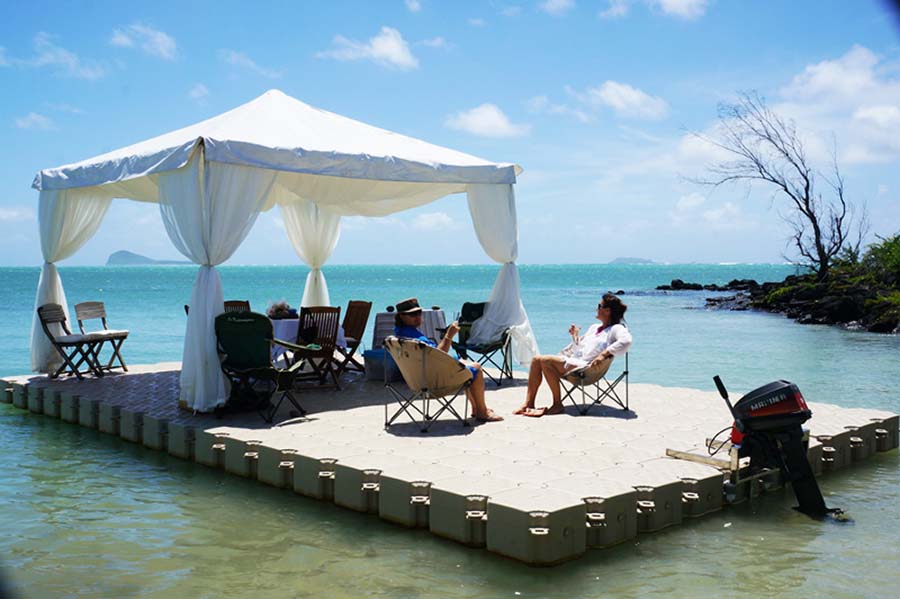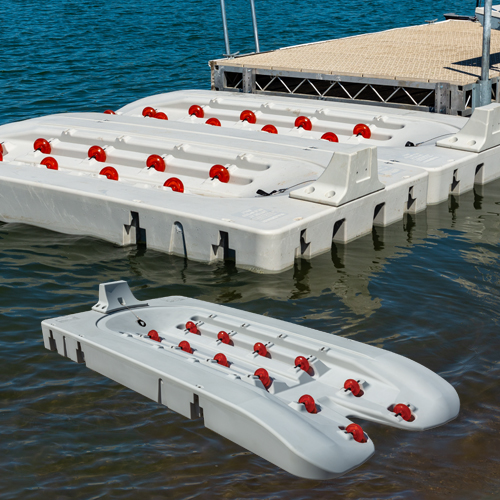Produce the Perfect Docking Solution With Floating Docks
Floating docks present a flexible service for a selection of maritime demands, adapting perfectly to rising and fall water degrees and varied vessel types. Their modular nature enables rapid installation and relocation, yet the selection of ideal products and layout features is vital for making certain both capability and visual charm. As we check out the necessary aspects that add to the efficiency of floating docks, numerous crucial aspects concerning security and maintenance will certainly emerge, increasing questions concerning just how to enhance your docking experience. The subsequent conversation will certainly illuminate these vital factors to consider.

Benefits of Floating Docks
Floating docks offer numerous advantages that make them an ideal option for different maritime applications. Unlike taken care of docks, floating docks surge and autumn with the tide, making certain consistent access for vessels.
Additionally, floating docks are normally easier and quicker to set up compared to typical fixed structures. Their modular style enables uncomplicated setting up and disassembly, facilitating maintenance and moving when necessary. This flexibility is especially beneficial for momentary applications or in settings where problems might change.
Floating docks additionally tend to be much more ecologically pleasant, as they reduce interruption to the seabed and surrounding marine communities. Their buoyant nature lowers the risk of damages to aquatic life, promoting a healthier atmosphere. These docks can be customized to suit different vessel sizes, guaranteeing that they satisfy certain operational needs.
Ultimately, the mix of adaptability, ease of installment, and ecological considerations makes floating docks an extremely effective option for a wide variety of maritime needs.
Choosing the Right Products
Picking the ideal materials for floating docks is essential to make certain long life, longevity, and security. The option of products directly affects the dock's performance in different ecological conditions, consisting of exposure to water, sunshine, and potential wear from aquatic web traffic.
Typical materials utilized for floating docks consist of aluminum, wood, and high-density polyethylene (HDPE) Light weight aluminum is lightweight, corrosion-resistant, and needs minimal upkeep, making it an exceptional choice for durability. However, its initial price can be higher contrasted to other materials.
Wood, while visually appealing and giving a standard appearance, can be at risk to rot and pest damages if not appropriately treated. Making use of pressure-treated timber or normally sturdy types like cedar or redwood can minimize these concerns.
HDPE is a prominent choice due to its resistance to UV rays and chemicals, along with being eco-friendly. floating dock company. It is light-weight and offered in various shades, permitting customization
Ultimately, the ideal product choice will certainly depend upon specific demands, including budget plan, desired appearances, and environmental factors to consider. Cautious assessment of these variables will certainly result in a effective and durable floating dock service.
Layout Considerations for Security
When making floating docks, guaranteeing stability is an essential facet that can considerably impact their capability and safety. Stability in floating dock layout is influenced by various elements, consisting of buoyancy, weight circulation, and the setup of components.
Weight circulation is essential; equally dispersing loads across the dock prevents turning and improves security. Broader styles can offer see it here raised security, especially in rough water problems, while longer docks may require additional assistances to prevent sagging.
An additional essential consideration is the ecological impact, consisting of wave action and wind. Incorporating attributes such as sidewalls or skirting can help minimize the impacts of environmental pressures, maintaining security in unfavorable problems. Eventually, a mix of thoughtful style, material selection, and understanding of ecological factors will certainly yield a drifting dock that satisfies both security and security needs.
Installation Tips and Strategies

Next, protect the needed licenses and stick to neighborhood laws, which might dictate setup approaches and ecological considerations. Involve a qualified specialist experienced in floating dock installations if needed. Use top quality products designed for aquatic environments to boost toughness and durability.
When placing the dock, straighten it alongside the coastline to promote simple access. Ensure that the anchoring system is durable, employing cinder block or helical supports to stabilize the dock versus wind and wave action. It's important to account for seasonal water degree fluctuations, including possible ice motion in colder environments.
During the installment, confirm the dock's floatation and stability prior to completing the anchoring. On a regular basis examine the installment for any type of indicators of wear or damage. By adhering to these ideas and techniques, you can achieve a safe, functional, and cosmetically pleasing floating dock installment that satisfies your needs.
Maintenance and Treatment Guidelines
Caring and keeping for floating docks is essential to lengthening their lifespan and guaranteeing risk-free use. Normal evaluations ought to be carried out to identify any type of signs of wear, damage, or marine growth. Try to find splits, loosened installations, or discolored areas on the dock's surface, as these issues can compromise structural integrity.
Cleaning is crucial. Make use of a stress washing machine to get rid of algae, barnacles, and debris, which can accumulate in time. For stubborn growth, think about ecologically pleasant cleansing representatives that will not harm aquatic life.
Additionally, examine the mooring lines and anchors often to ensure they are totally free look these up and secure from corrosion. Change any kind of torn or damaged lines quickly to maintain security.
Throughout severe weather condition, such as storms or freezing conditions, take precautionary actions. Safeguard the dock with additional mooring lines and, reference if feasible, remove any detachable components to avoid damage.
Final Thought
In verdict, the implementation of floating docks provides a reliable and functional docking solution suitable for various maritime applications. Their adaptability to varying water levels, incorporated with a modular style, enables for easy customization and relocation. Choosing proper materials improves both durability and aesthetic appeal, while mindful consideration of security makes certain safety and security and longevity. With correct installation and normal maintenance, floating docks can supply reputable and effective docking experiences for a vast array of vessels.
As we explore the vital elements that contribute to the performance of floating docks, several crucial factors pertaining to stability and maintenance will arise, increasing inquiries concerning how to maximize your docking experience. Unlike fixed docks, floating docks rise and autumn with the tide, making sure regular ease of access for vessels.When making floating docks, ensuring security is a fundamental aspect that can dramatically influence their capability and safety. Stability in floating dock layout is affected by numerous factors, including buoyancy, weight distribution, and the arrangement of components. Ultimately, a combination of thoughtful design, material choice, and understanding of ecological aspects will certainly generate a floating dock that satisfies both stability and safety requirements.